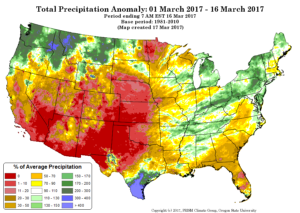Chris Harris, the new executive director of the Colorado River Board of California (just named to the job Wednesday, congratulations, Chris!) made a point in the comments of this post that’s worth highlighting. While the dry March in the Upper Colorado River Basin has eating into the runoff forecast, likely eliminating the chance of a huge pulse of bonus water for Lake Mead under the “equalization” of Lake Mead and Lake Powell, the implications of the good snowpack are significant, and will be long lasting:
While it seems like “good news, bad news” for Mead; in my opinion, it really isn’t–it is all good news, in my opinion. First, even though we may not have equalization releases in 2017, the probability for equalization releases in 2018 likely have gone up significantly. The runoff into Powell this year will be very, very good. Secondly, the side-inflows from tributaries between Glen Canyon Dam and Mead are currently 200% of average and have contributed something like two feet of elevation to Mead. I think the probability for shortage in 2018 is now very, very low. None of this takes into account any of the water supplies that will be left in Mead as a result of ICS or system conservation contributions. Finally, because of the wet winter uses are way down in the Lower Basin so far this year, again resulting in water being left in Mead. One would think this gives all of us a little bit of time to forge ahead with drought contingency planning and binational discussions.
Those last two points are critical.
The flows into Lake Mead from the main tributaries upstream from the reservoir but below Lee Ferry (“side-inflows”) are essentially “free water” for the Lower Basin, not counted against the Upper Basin’s compact delivery. And because of the wet weather, farmers in the Lower Desert are taking far less water out of Lake Mead than anticipated. As a result, Mead ended February 5 feet above its level of a year earlier, only the third such year-over-year since The Troubles began in 2001.
That combines with good water supply news elsewhere in California. Great snow in the eastern Sierra Nevada means Los Angeles will have good supplies to fill its the L.A. Aqueduct. Southern California also is likely to get a decent supply of water from Northern California. Those factors, combined with low demand (because of the wet winter and successful conservation), further reduce pressure on the Colorado River, because metropolitan Southern California doesn’t need as much.
It’s still early, but the current forecast (pdf) calls for California’s take on the Colorado this year to be under 4 million acre feet of its allotted 4.4 maf. Total forecast U.S. use is under 7 million acre feet of an allotted 7.5 maf.

